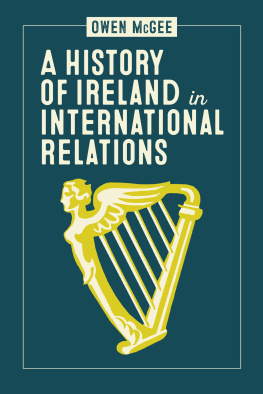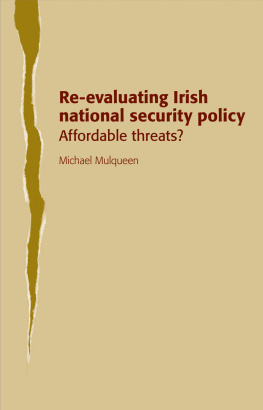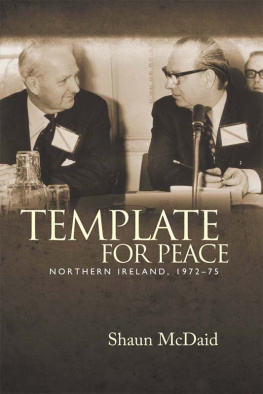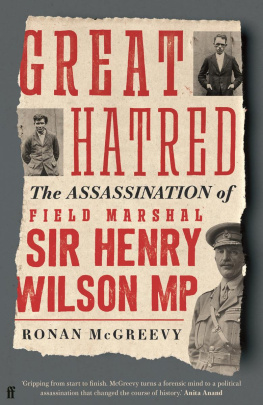BOMBS, BULLETS
AND THE BORDER
Patrick Mulroe is a teacher in Monaghan with a PhD in Politics; living and working in the border area, he has an extensive knowledge of all aspects of border life.
This is the most important study of how the conflict in the North impacted on the security of the southern Border counties. By trawling state archives, local newspapers and contemporary accounts, Mulroe has skilfully brought to life a period many would like to forget.
Dr Brian Hanley, historian, lecturer and writer
The role of the Irish state has become an issue of prime importance in current debates over the legacy of the Troubles. Patrick Mulroe provides us with a detailed, comprehensive and forensic analysis of the challenge posed by republican and loyalist terrorists to successive Irish governments during the worst years of the Troubles. He reveals the dilemma faced by successive Irish governments of responding to a direct challenge by the Provisional IRA without leaving themselves open to charges of collaboration with the British. This critical but sympathetic account will be indispensable for an understanding of the evolution of the IRAs long war and the spiky history of Anglo-Irish relations in this crucial period.
Professor Henry Patterson, Emeritus Professor of Politics, University of Ulster, Jordanstown
Patrick Mulroes book shines a penetrating light on the under-studied role of the Irish governments security policy during the early years of the Troubles. This volume uncovers and illuminates the complexities that the Irish Republic faced in its vexed border relationship with Northern Ireland and the rest of the United Kingdom. The results might surprise even seasoned analysts of contemporary Irish history, revealing that even during the worst of times in the Northern crisis there was often, in fact, far more empathy and understanding of the mutual security dilemmas each state faced than hitherto might have been presupposed.
M.L.R. Smith, Department of War Studies, Kings College, University London
This important book, based on extensive archival research in both London and Dublin, examines the contentious subject of security relations between the British and Irish governments in the first decade of the recent Troubles. Its great strength is the authors forensic examination of the delicate political line which Irish governments had to tread between popular nationalist sentiment and their responsibility to negate threats to the Republics stability. Not only does Mulroe make an original contribution to our knowledge of the history and politics of this period, he also adds to our understanding of contemporary problems of border security.
Professor Cathy Gormley-Heenan, Pro-Vice-Chancellor, Research & Impact, University of Ulster
BOMBS, BULLETS
AND THE BORDER
Policing Irelands Frontier:
Irish Security Policy, 19691978
PATRICK MULROE

First published in 2017 by
Irish Academic Press
10 Georges Street
Newbridge
Co. Kildare
Ireland
www.iap.ie
2017, Patrick Mulroe
978-1-911024-49-1 (Paper)
978-1-911024-50-7 (Cloth)
978-1-911024-51-4 (Kindle)
978-1-911024-52-1 (Epub)
978-1-911024-61-3 (PDF)
British Library Cataloguing in Publication Data
An entry can be found on request
Library of Congress Cataloging in Publication Data
An entry can be found on request
All rights reserved. Without limiting the rights under copyright reserved alone, no part of this publication may be reproduced, stored in or introduced into a retrieval system, or transmitted, in any form or by any means (electronic, mechanical, photocopying, recording or otherwise) without the prior written permission of both the copyright owner and the above publisher of this book.
Interior design by www.jminfotechindia.com
Typeset in ITC New Baskerville 11/14 pt
Cover/jacket design by edit+ www.stuartcoughlan.com
Front cover/jacket: Photo by Derek Speirs.
Back cover/jacket: Courtesy of An Phoblacht .
Printed in Ireland by SPRINT-print Ltd
Contents
Acknowledgements
This book examines a deeply troubled time in Irish history. There have been excellent works written on the impact of the Troubles on the northern border counties but the focus of this work is on the southern border counties, and while events that take place in Northern Ireland are covered, these are not the primary focus.
I owe a sincere debt of gratitude to my supervisors Professors Henry Patterson, Arthur Aughey and Cillian McGrattan and my examiners Professor Cathy Gormley-Heenan and Professor Michael Rainsboroug. The support I was given at University of Ulster was second to none. Proofreaders Petrina Mulroe, Michelle Dowling, Michael Treanor and Sinead McDermott provided feedback at crucial times. Two fellow teachers, Finbarr Brohan and Joe Hanratty, did Trojan work further tidying up the text and are among the many outstanding colleagues at Our Ladys Secondary School who continually encouraged me to complete my studies. I also received invaluable feedback from Dr Brian Hanley. At Irish Academic Press, Conor Graham and Fiona Dunne have both been a pleasure to work with. Mark Dawson in An Phoblacht and Derek Speirs did great work helping me source pictures and the staff the Military Archives and the National Photographic Archive were extremely helpful.
I am particularly grateful to those who supported me on a personal level: my sisters Eibhlin, Teresa, Petrina and Jacinta; brother-in-law, Mark; and parents provided great support. Sincere thanks are also due to Margaret Gillespie, Fiona McManus, Niall Treanor, Barry McDonald, Darren McArdle and Niall McCarville. Other friends also helped at key times: Tom and Margaret Treanor, John Coggins, Colin Colleran, Marco Conte, Brian ONeill, Gerard McArdle, Damian Lawlor, Micky Morgan, Mick Pierse, Declan McKenna, Mark Daffy, Fra Agnew, Patricia McDermott, and Paul and Aidan McDonald.
Finally, I would like to thank my students, who have been a constant source of inspiration. I like to think I have helped some of them through the years but they have given me much more: their friendship, good humour and respect speak volumes for them as individuals, their families and the wider community in Castleblayney, Co. Monaghan.
The mystique of the unified nation-state: Introduction
L ooking at newspaper coverage of the Troubles over a few random days in June 1974 is illuminating. The Irish Times reported on 26 June that British soldier Eugene Patton had managed to escape from his IRA kidnappers and was back at home with his family in St Johnson, Co. Donegal.
The previous day, the Irish Press reported that two young IRA men had been killed when their own device exploded prematurely in Derry. One of the dead men was David Russell. These news stories were not untypical of the times and they illustrate a range of points about the Irish border in the 1970s. Firstly, and quite obviously, it could be dangerous. Secondly, the situation was complex and simplistic assumptions about individuals and events should be avoided. Finally, the full truth of certain events may never be known.
The Northern Ireland conflict has received extensive academic and journalistic coverage dealing with almost every aspect of the situation, and the increased availability of archive material and first-hand have looked at the impact of violence on the Northern side of the border. This work aims to see how the southern state dealt with the threats, real and perceived, that it faced.
The official British Army report on the conflict, Operation Banner , noted that in the early years of the Troubles it was widely believed in the North that the Garda colluded or at least turned a blind eye; as long as IRA men did not break the law in the Republic.
Next page








